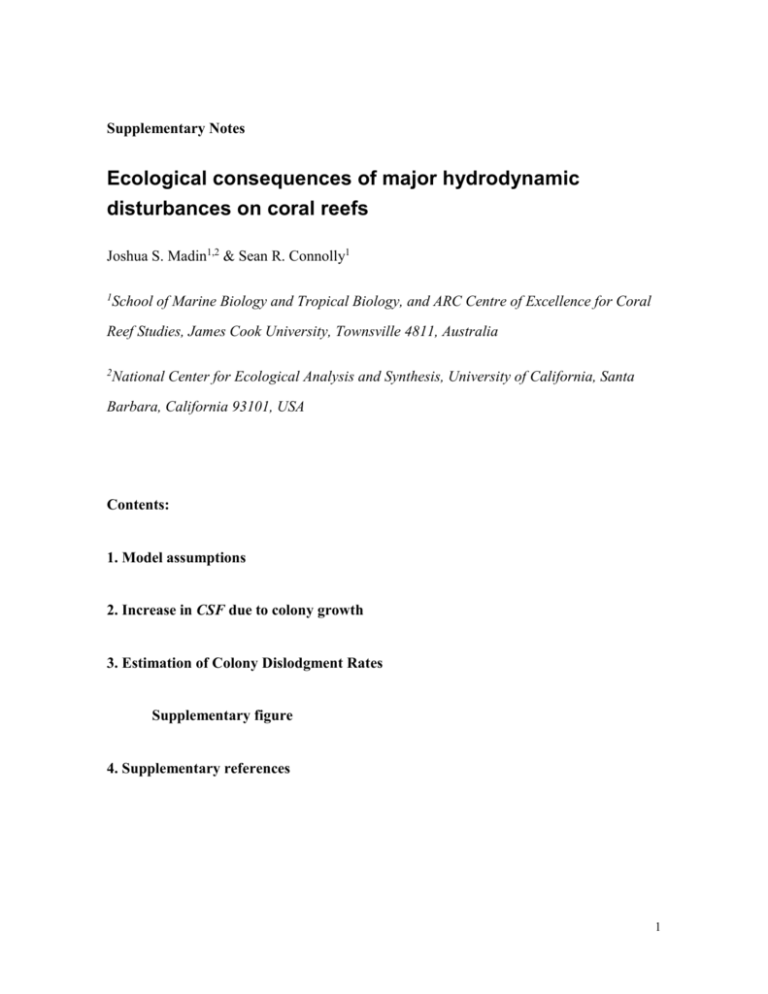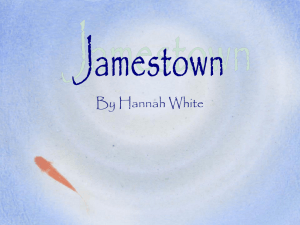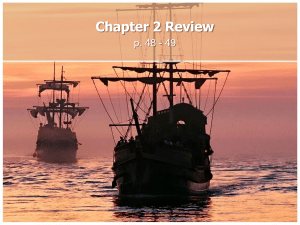
Supplementary Notes
Ecological consequences of major hydrodynamic
disturbances on coral reefs
Joshua S. Madin1,2 & Sean R. Connolly1
1
School of Marine Biology and Tropical Biology, and ARC Centre of Excellence for Coral
Reef Studies, James Cook University, Townsville 4811, Australia
2
National Center for Ecological Analysis and Synthesis, University of California, Santa
Barbara, California 93101, USA
Contents:
1. Model assumptions
2. Increase in CSF due to colony growth
3. Estimation of Colony Dislodgment Rates
Supplementary figure
4. Supplementary references
1
1. Model assumptions
Hydrodynamic Forces.—There are three types of hydrodynamic force that act upon a
coral colony as a wave passes: inertial, lift and drag1. This study focuses on drag forces
produced by horizontal water velocity generated by passing waves, as these should be the
dominant force acting on reef corals as a wave passes1. Inertial force is induced by water
acceleration and is relatively small for wave-swept sub-tidal attached organisms, relative to
velocity-induced forces2. Moreover, because water acceleration is maximal when velocity
is minimal (i.e., they are half a wavelength out of synchronisation), the relatively small
inertial forces do not compound the affects of velocity-induced forces3. Similarly, velocityinduced lift force, which acts vertically on a colony, is typically an order of magnitude less
than drag force for mound-shaped morphologies4. Because there are no data on lift
coefficients for coral colonies, we ignore lift force.
Drag coefficients.— The only published records of drag coefficients for corals report
a range between 0.82 and 1.02 for the tabular-like species Acropora reticulata5. Moreover,
the drag coefficient for a cylinder attached at one end to a substrate is equal to one6.
Because the predicted water velocity threshold (Eq. 2) is relatively insensitive to small
deviations in the drag coefficient (e.g., there is a 5% disparity in the predicted water
velocity threshold between colonies with drag coefficients of 1.0 and 0.9 or 1.0 and 1.1),
we assume a drag coefficient of one for all species.
Water velocity as a function of height above the substrate.—Due to the periodic
motion of waves, reef-scale boundary layers do not have sufficient space or time to form in
shallow habitats3,8,9, and were not included in the model. On a shallow reef platform (1-4m
depth), the difference in water velocity that is generated by orbital wave motion between
2
the reef substrate and the top of a large coral colony is negligible3. Therefore, when
approximating CSF, we assume that there is no appreciable change in water velocity as a
function of colony height, and thus that the mainstream water velocity acts equally on all
regions of the colony.
2. Increase in CSF due to colony growth
To estimate rates of increase in CSF for A. hyacinthus, we used published estimates
of colony growth rates under uncrowded conditions (120% increase in planar area per
year10). The exponent of the power-law relationship between CSF and planar area,
calculated from the regression of log(CSF) versus log(area) in Fig. 2a, is 0.67, yielding an
estimate of annual increase in CSF due to colony growth of 70%, or a factor of 1.7 per year.
The difference in the thresholds plotted in Fig. 1 is approximately two-fold, suggesting that
approximately 1.3 years of colony growth would be required for a colony just below the
threshold of Rona in 1999 to reach the more typical annual threshold of 2002. Even a much
more conservative estimate of colony growth (60% increase in area per year) yields an
estimate of only 2.2 years for a doubling of CSF.
We know of no published estimates of colony growth rates in A. gemmifera.
However, A. humilis, which is a member of the same species group and has a similar
growth form, grows at approximately 20% the rate of A. hyacinthus11. The exponent of the
power-law relationship between CSF and planar area for A. gemmifera is 0.53 (slope of the
regression line through solid points in Fig. 2b), yielding an estimate of annual increase in
CSF due to colony growth of approximately 12%. By this estimate, it would take over 6
years (more than 4 times longer than A. hyacinthus) for a colony’s CSF to increase from the
Rona threshold to the 2002 threshold. If we repeat these calculations using the more
3
conservative estimate of colony growth for A. hyacinthus as a starting point, we obtain an
even larger estimate of the time required for a doubling in CSF (~12 years), which is sixfold longer than the corresponding estimate for A. hyacinthus.
3. Estimation of Colony Dislodgment Rates
If hydrodynamic disturbances of sufficiently large magnitude occur at a constant
stochastic rate (i.e., independently of how recently the last one occurred), then the time
intervals between successive mortality events should be approximately exponentially
distributed12:
g(t) e t
(S1)
where t is time and is the stochastic rate at which disturbances occur. To test the
accuracy of this assumption, we generated frequency distributions of waiting times between
events of magnitudes necessary to dislodge colonies of a given CSF located at the reef crest
using our theory and the 37-year hydrodynamic database13. We then fitted Eq. S2 to these
distributions using standard maximum likelihood methods. Comparison of observed and
predicted frequency distributions indicates that the exponential distribution exhibits
excellent fit to the data (see Supplementary Figure). This indicates that the fitted rate
parameter accurately approximates the instantaneous rate at which coral colonies of a
given CSF are dislodged by disturbance.
4
Supplementary figure | Frequency distributions of waiting times between
predicted mortality events at the reef crest for four values of CSF. Bars
represent observed frequencies and points and lines are expected frequencies.
The CSF, the estimated rate of colony dislodgment, (year-1), and the number of
predicted events during the 37-year wave database are given for each panel.
4. Supplementary references
1. Denny, M. W. Predicting physical disturbance: mechanistic approaches to the study of
survivorship on wave-swept shores. Ecol. Monogr. 65, 371-418 (1995).
5
2. Denny, M. W. Are there mechanical limits to size in wave-swept organisms. J. Exp. Biol.
202, 3463-3467 (1999).
3. Denny, M. W. Biology and the Mechanics of the Wave-Swept Environment. Princeton
University Press, New Jersey (1988).
4. Denny, M. W. Limits to optimization: fluid dynamics, adhesive strength and the
evolution of shape in limpet shells. J. Exp. Biol. 203, 2603-2622 (2000).
5. Vosburgh, F. Acropora reticulata: structure, mechanics and ecology of a reef coral.
Proc. R. Soc. Lond. B 214, 481-499 (1982).
6. Gerhart, P. M., Hochstein, J. I. & Gross, R. J. Fundamentals of Fluid Mechanics. 2nd Ed.
Pearson Addison Wesley, New York (1992).
8. Nowell, A. R. M. & Jumars, P. A. Flow environments of aquatic benthos. Annu. Rev.
Ecol. Syst. 15, 303-328 (1984).
9. Shashar, N., Kinaneb, S., Jokiel, P. L. & Patterson, M.R. Hydromechanical boundary
layers over a coral reef. J. Exp. Mar. Biol. Ecol. 199, 17-28 (1996).
10. Tanner, J. E. Interspecific competition reduces fitness in scleractinian corals. J. Exp.
Mar. Biol. Ecol. 214, 19-34 (1997).
11. Stimson, J. The effect of shading by the table coral Acropora hyacinthus on understory
corals. Ecology 66, 40-53 (1985).
12. Sokal, R. R. & Rohlf, F. J. Biometry. W. H. Freeman and Company, New York (1981).
13. Madin, J. S., Black, K. P. & Connolly, S. R. Scaling water motion on coral reefs: from
regional to organismal scales. In press at Coral Reefs (published online August 2006, DOI
10.1007/s00338-006-0137-2).
6










